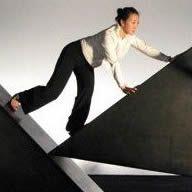Aurélien Bory’s Les Sept Planches de la Ruse, Barbican London
In our fantastical climate of montage and mosaic, the ever-stretched scandal of dissociation and the outrageously absurd, Aurélien Bory’s Les Sept Planches de la Ruse is simplistic, organic and pure” an homage to gravity, humility and overriding peace in the greater forces.
The production concept is drawn from the ancient Chinese riddle of the tangram: a mental challenge which calls for the arrangement of seven shapes to replicate a complex geometric shadow form, of which there exist tens of thousands of possible permutations.
The quantifying difference, here within the context of corporeal mime, is that the importance of the journey of these puzzle pieces well exceeds the rush towards their destination, if indeed a destination is set in place. Bory’s tangram is of architectural proportions, towering over its workforce, touching lightly on the realm of the third dimension. Its ‘seven boards of skill’ are set into motion by the bodyweights of the troupe, who push, pull and leap onto the pieces as they inch through their monochrome kaleidoscope.
Exotic in its discipline, this show is an extended and unusual object animation using the brushstrokes of Beijing opera. It is a puppetry of urban landscape, a manipulation of scale and form, of symmetries and balance. Its movement is too grounded to constitute acrobatics, yet demands an elasticism and agility embedded in gymnastic function. Its characters are unassuming in their formalwear” suits, ties, cheongsams naturalise their monkeying movements. They weave a masterwork of timing” their humour refreshingly existential in its wavering vocal vibrato and unsuspecting flexibilities” their strength and trust in the face of danger.
Despite the French, there is no ruse at play here. This geometry-inspired hypnosis speaks neither of trickery nor sham, instead of a truth and reality bigger than humankind. The only deception is in the indeterminate weight of the giant pieces, at times swept along by the tide of inertia, at others as leaden as the tectonic plates they conjure. Equal parts remarkable as unremarkable, these seemingly magnetic men pad lightly down the hypotenuse: this is a lip-biting drama of inevitability and a deferent, wondrous theatre of ch’i.





